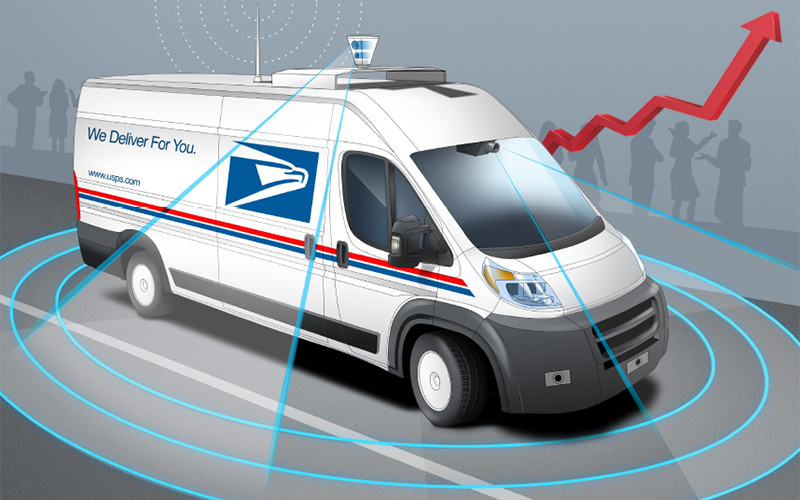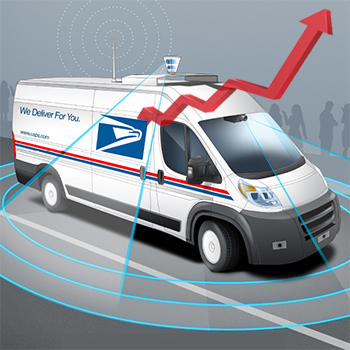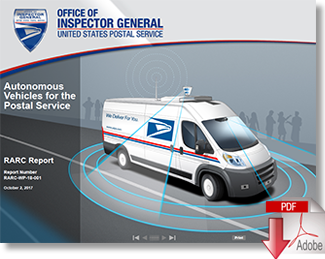U.S. Postal Service Announces New Prices for 2018 - Looking at Autonomous Mail Trucks by 2025

The United States Postal Service filed a notice with the Postal Regulatory Commission of price changes to take effect Jan. 21, 2018, while at the same time the Office of Inspector General announced they are researching autonomous vehicles in order to increase driver safety, reduce fuel costs, and improve worker productivity.
That time has come for rate increases by the United State Postal Service (USPS), which were rolled out last week.
As usual, these announced 2018 increases were filed in a notice with the Postal Regulatory Commission (PRC), and, if the price increases are approved, they would take effect on January 21, 2018.
But, as the Wall Street Journal observed, these rates increases could be challenged, as price hikes need to be signed off by the USPS Board of Governors, a board that has been member less since December 2017.
What’s more, the financial outlook of the USPS continues to remain in dire straits, with mail volume continuing to see steady declines due to the ongoing diversion to electronic alternatives like e-mail, coupled with defaulting on around $40 billion in the Postal Service Retiree Health Benefits Fund (PSRHBF) and mandated certain obligations for paying the normal costs and prefunding of retiree health benefits, as per the Postal Accountability and Enhancement Act, which was signed into law in 2006.
This situation has significantly hindered its financial position, which has led the USPS to call for “legislative and regulatory change.” USPS has repeatedly said that its long-term financial stability depends on the PRC establishing a new pricing system that enables the organization to generate sufficient revenues to cover its costs.
In August, the USPS reported a net loss for $2.1 billion for the fiscal third quarter, an increase in net loss of $573 million, compared to the same quarter last year. The controllable loss for the quarter was $587 million, an increase in controllable loss of $35 million, driven by higher transportation costs.
“The growth in our lower-margin package business is not sufficient to make up for the accelerating mail volume declines,” said Postmaster General and CEO Megan J. Brennan in a statement.
“Our financial situation is serious but solvable. The continuation of aggressive management actions and legislative and regulatory reform will return us to financial stability and enable the Postal Service to maintain the long-term affordability of mail, invest in America’s mailing and shipping industry, and best serve the American public.”
Of key interest to shippers in the announced rate increases is that “most” Shipping Services products, a key USPS revenue driver spurred on by ever-increasing e-commerce activity, last mile e-commerce fulfillment markets, and Sunday delivery, will average a 3.9% price increase. USPS added that prices for Shipping Services are adjusted strategically based on market conditions and the need to maintain affordable services for customers.
Jerry Hempstead, president of Hempstead Consulting, provided Logistics Management with an overview of key aspects of the announced USPS rate increases for shippers, including:
- First Class Package rates: shipments in the 1-5 oz range see a modest 1-2% increase but jump significantly year over year in the 5 oz weight category (5%) and in the 7 and 8 oz category (10 and 15%, respectively).
- Flat Rate: Flat rate products will increase by an average of 7%, with the padded flat rate envelope increasing by 10%. The small flat rate box will increase by 10%, while the larger sizes will only increase by 3-4%.
- Cubic pricing will increase by 5.2%; the larger tiers, however, will decrease by a slower rate at 2% year over year.
- Parcel Select and Parcel Select Lightweight. The Parcel Select products are the most popular options in e-commerce. FedEx, UPS and many other carriers utilize these “final mile” products where final delivery is performed by the USPS with products such as FedEx SmartPost and UPS SurePost or Mail Innovations. Note the following: Parcel Select Lightweight will increase by an average of 5.3%. The average increase for Parcel Select (DDU entry) for packages 1-10lbs is 7.4%.
- While 5.3 and 7.4% year over year increases may seem somewhat surprising, it is important to note that the Parcel Select service has rapidly gained in popularity, especially with e-commerce shippers and carriers themselves who wish to utilize the strong residential delivery network of the USPS.
What it all means? While some services have increased at a faster rate than others, the overall year over year increases are fairly modest. It is also important to note that no new USPS surcharges have been added for 2018, thus making these services a good option as part of a shipping strategy mix.
While the announced 3.9% [average Shipping Services] increase is in line with previous years increases, the actual impact to any given shipper will vary greatly depending on what services and lanes they ship most, Gordon Glazer, senior consultant for San Diego-based parcel consultancy Shipware LLC, said.
“It is very evident that the United States Postal Service did their homework and took their largest percentage increases in the lanes that are consistently lower than their competition.”
“The highest increases are in the lower weights and inner zones, where they usually win when compared with fully landed costs (including surcharges, fuel, dimensional weight, etc.). This is a continuing trend by the USPS, to increase margin without hurting volume. There is a lot of variance in the changes, users of the popular Priority Mail (PM) Flat Rate Envelopes will see their costs increase 10% while those who use PM Regional Flat Rate will see an 11% decrease. High volume residential shippers using the popular Parcel Select (PS & PSL) services (ie; UPS SurePost, UPS Mail Innovations, DHL e-Commerce, Newgistics, OSM and FedEx SmartPost) will feel the impact of 5.3% and 7.4% increases in the lightweight (PSL) and over a pound categories (PS) respectively.”
These consolidator service models, he explained, vary greatly in how they utilize Parcel Select and how they pass along these increased costs will vary by carrier and by their client contracts.
Glazer also added that shippers “will be well advised” to model these changes against their historical spend to gauge the true impact while also comparing competitive services with their annual increases and surcharges.
“After going through this exercise, shippers may find the USPS is even more attractive than before, especially when also comparing alternative modes like USPS PM Cubic where the pricing is based upon volume, not weight,” he concluded.
Given the ongoing top-level financial turmoil for the USPS, its Shipping Services group continues to stand out as a viable option for both business and consumer customers. While it may not be the rising tide to lift all USPS boats, this group clearly has its oars in the water and is ready to help lead the USPS to financial daylight.
Autonomous Vehicles for the Postal Service
Driverless cars have captured imaginations for decades, but the past few years have seen the technology move from dream toward reality.
More formally known as autonomous vehicles, these self-driving cars and trucks have the potential to transform not only personal mobility but transportation and delivery as well.
Other logistics companies are already researching ways they can realize the technology’s promise to increase safety, reduce fuel costs, and improve worker productivity.
The Office of Inspector General (OIG) has identified ways the Postal Service could use the technology in last-mile delivery and trucking. Applications include autonomous vehicles that assist carriers in delivering mail, a mobile parcel locker that is a complete departure from current delivery methods, and autonomous trucks that handle the transportation of mail on highways.
While none of the suggested use cases could be fully deployed today, it is worthwhile for the Postal Service to research and test the technology now so that USPS can be ready for the transportation network of the future.
In fact, the Postal Service has already started to test the technology. The OIG suggests the Postal Service take a step-by-step approach: continuing to test the technology first, gradually automating vehicles where it makes strategic sense, and refining its AV strategy as the technology, market, regulation, and public perception evolve.
- Logistics companies, including the U.S. Postal Service, are already researching autonomous vehicles in order to increase driver safety, reduce fuel costs, and improve worker productivity.
- The OIG identified seven distinct ways the Postal Service could use the technology for last-mile delivery and long-haul transportation.
- Despite some remaining hurdles to full implementation, now is the time for USPS to begin testing the technology and refining its transportation strategy for the future.
Download the Report: Autonomous Vehicles for the Postal Service
Article Topics
USPS News & Resources
Parcel Experts Weigh in on New Partnership Between UPS and USPS Parcel experts examine the UPS-United States Postal Service air cargo relationship amid parcel landscape UPS To Become USPS’s Main Air Cargo Provider, Replacing FedEx UPS is set to take over USPS air cargo contract from FedEx Next steps in FedEx-USPS business relationship are uncertain with contract set to expire at end of September Major parcel carriers turn in strong Cyber Week on-time performance levels, reports ShipMatrix Logistics services providers and shippers call out for seasonal help More USPSLatest in Transportation
Talking Supply Chain: Doomsday never arrives for Baltimore bridge collapse impacts Amazon Logistics’ Growth Shakes Up Shipping Industry in 2023 Nissan Channels Tesla With Its Latest Manufacturing Process Why are Diesel Prices Climbing Back Over $4 a Gallon? Luxury Car Brands in Limbo After Chinese Company Violates Labor Laws The Three Biggest Challenges Facing Shippers and Carriers in 2024 Supply Chain Stability Index: “Tremendous Improvement” in 2023 More Transportation
















